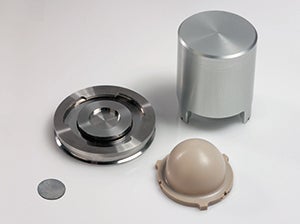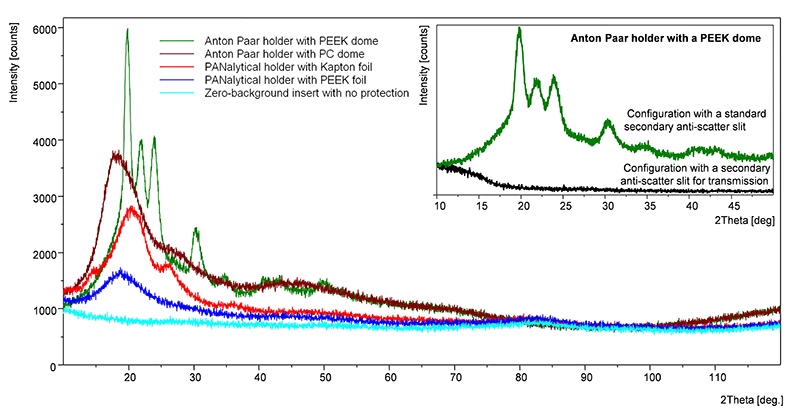Air-sensitivity of a sample material (change of properties in direct contact with oxygen or/and water) is an important issue for many research fields. Besides other materials, a large number of pharmaceuticals and materials for gas storage applications requires an oxygen-/water-free atmosphere for their characterization.
On the one hand, sample material should be well protected from contact with air during a characterization process; on the other hand, a sample should still be accessible for the analytical tool in use. X-ray diffraction (XRD) has two main requirements (apart from good air-tightness) for such a protection: (i) a certain level of transparency for X-rays and (ii) minimal contribution to a diffraction pattern. Naturally, air-tightness and transparency to X-rays are two competing factors. Therefore an optimal sample holder should be chosen based on the specifics of a particular sample, mainly based on its degree of sensitivity to air/water (i.e. the speed of decomposition in direct contact with air/water).
To make this choice easier, our sample holders with foil protection for air-sensitive materials and Anton Paar domed sample holders are compared. Three main factors are benchmarked: air-tightness, X-ray transparency and a contribution to the XRD pattern. As testing material an extremely air sensitive compound was used: LiH (lithium hydride), which in direct contact with air decomposes almost completely within one hour.
Please login or register for free to read more.
Air-sensitivity of a sample material (change of properties in direct contact with oxygen or/and water) is an important issue for many research fields. Besides other materials, a large number of pharmaceuticals and materials for gas storage applications requires an oxygen-/water-free atmosphere for their characterization.
On the one hand, sample material should be well protected from contact with air during a characterization process; on the other hand, a sample should still be accessible for the analytical tool in use. X-ray diffraction (XRD) has two main requirements (apart from good air-tightness) for such a protection: (i) a certain level of transparency for X-rays and (ii) minimal contribution to a diffraction pattern. Naturally, air-tightness and transparency to X-rays are two competing factors. Therefore an optimal sample holder should be chosen based on the specifics of a particular sample, mainly based on its degree of sensitivity to air/water (i.e. the speed of decomposition in direct contact with air/water).
To make this choice easier, our sample holders with foil protection for air-sensitive materials and Anton Paar domed sample holders are compared. Three main factors are benchmarked: air-tightness, X-ray transparency and a contribution to the XRD pattern. As testing material an extremely air- sensitive compound was used: LiH (lithium hydride), which in direct contact with air decomposes almost completely within one hour.
A sample holder consists of a steel bottom plate with a cavity for the sample material. In case of a low sample amount or low molecular weight a zero-background insert (off- cut Si monocrystal) can be used. The sample is covered with a polymer foil (7.5 μm Kapton or 6 μm polyether ether ketone - PEEK), which is secured by a polyoxymethylene ring. Transparency for X-rays is 95% for both Kapton and PEEK foils. This sample holder design allows contact between a sample and the protecting polymer foil.
Figure 1. Sample holder with zero- background insert
This holder consists of a steel base plate with a cavity for a sample (optionally a zero-background insert can be used) and a plastic dome, which is fixed on a base plate with a special locking mechanism. Two dome materials are available: polyether ether ketone (PEEK) and polycarbonate (PC). Air-tightness of the contact between base plate and dome is ensured by an O-ring. A special tool is available for mounting and dismounting a dome from a base plate. Transparency for X-rays is 70% for both PEEK and PC domes. In this design there is no contact between sample surface and dome.
Figure 2. Anton Paar dome sample holder with a PEEK dome and zero-background insert (inset)

In order to compare the sample holders with respect to their air- tightness, contribution to XRD background and transparency for X-rays, a set of XRD data was collected. Background contributions were measured from the sample holders with zero-background inserts and no sample loaded. To estimate the air-tightness, five data sets, monitoring the oxidation rate of LiH loaded in the different sample holders, were obtained.
Due to the low molecular weight (i.e. high X-ray transparancy) of LiH zero- background substrates were used. Sample loadings were performed in an oxygen- and water-free atmosphere (N2 gas) using a glove bag. Prior to loading all metal components of the holder, the zero-background substrates as well as the loading tools were dried at 105 °C for 2-3 h. The glove bag was vented five times before sample preparation. Immediately after loading a sample was transferred on a diffractometer for monitoring of the oxidation process as a function of time.
Scheme of experimental setup: Bragg-Brentano geometry with a PIXcel3D detector
In Figure 3 XRD backgrounds from all discussed air-sensitive sample holders are compared with the background from a zero-background insert alone. The XRD background from an air-sensitive sample holder with PEEK foil is the lowest and the most featureless, while the background from an Anton Paar sample holder with PEEK or PC dome, shows a number of strong features. The XRD background with a domed sample holder can be improved by placing an anti-scatter slit closer to the sample. The insert of Figure 3 compares the XRD background of a domed sample holder measured using a standard programmable secondary anti-scatter slit with a background measured using a fixed secondary anti-scatter slit for transmission. In the latter measurement, the PEEK dome background contribution is significantly reduced.
For better comparison of the background contributions, XRD patterns measured from LiH loaded in the different air-sensitive sample holders are shown in Figure 4. Despite the strong background from PEEK and PC domes, the sample’s Bragg peaks are clearly resolved. Quantification using Rietveld refinement (as well as Le Bail or line profile analysis) can be performed on XRD patterns measured from LiH loaded in all air-sensitive sample holders used.

Figure 3. XRD background from different sample holders (in all cases a zero-background insert was used). Insert: comparison of a domed sample holder XRD background measured using configuration with a standard secondary anti-scatter slit and an anti-scatter slit for transmission.

Figure 4. Typical XRD patterns of LiH loaded in different air-sensitive sample holders
To estimate air-tightness, the speed of oxidation of LiH loaded in the different sample holders was monitored over several hours by XRD. The weight percentages of LiH were extracted using sequential automatic Rietveld refinement available in HighScore Plus. In Figure 5 the reduction of LiH is plotted as a function of time for five different sample loadings: LiH protected from air by the PEEK or PC dome, Kapton or PEEK foil and ‘unprotected’ LiH loaded in a holder with zero- background insert.
As seen from Figure 5 the Anton Paar holder with a PEEK dome shows the best air-tightness, there is virtually no decomposition of LiH during 16 h of measurements. However, this ‘insensitivity to air’ comes at the price of a strong background contribution from the PEEK dome. Air-tightness of an Anton Paar holder with a PC dome is lower and comparable to the air- tightness of an air-sensitive sample holder with a Kapton foil.
Therefore a sample holder with a Kapton foil is preferred for a given sample oxidation rate and if contact between sample and air protection is possible (due to its lower background contribution and higher X-ray transparency). The sample holder with a PEEK foil has the lowest air-tightness of the discussed sample holders. However, for a sample with a low oxidation rate this option would be preferred as PEEK foil has an almost featureless background (see Figure 3).
Figure 5. Decomposition of LiH due to oxidation for five cases: LiH in an Anton Paar domed sample holder with a PEEK dome (blue circles) and PC dome (red circles); LiH in an air-sensitive sample holder with Kapton foil (green triangles) and PEEK foil (black triangles); LiH placed on a zero-background holder with no protection (brown diamonds)
When choosing an optimal sample holder factors as sample air-sensitivity and 2theta range of interest should be taken into account. For extremely air- sensitive samples air-tightness of a holder is the most important factor, while for samples with a moderate or low sensitivity to air, the transparency for X-rays and background contribution can be taken into account as well. Based on the presented results we suggest the following guidelines:
Extreme sensitivity to air -> Anton Paar sample holder with a PEEK dome
Moderate sensitivity to air -> air-sensitive sample holder with a Kapton foil. Anton Paar holder with PC dome (if contact with sample is not desired)
Low sensitivity to air -> air-sensitive sample holder with PEEK foil. Anton Paar holder with PC dome (if contact with sample is not desired)